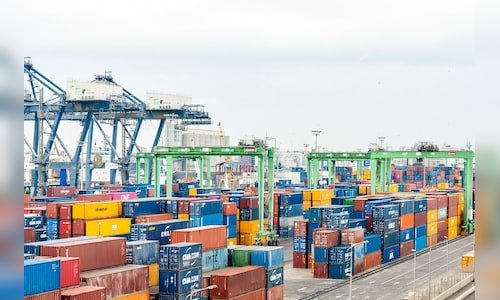Nomura now projects India’s GDP growth at 6% for FY26, slightly below the RBI’s earlier forecast of 6.7%. “The impact is manageable, but the indirect effects of broad-based global tariffs could weigh on trade and investment,” said Sonal Varma, Managing Director and Chief Economist- India and Asia Ex-Japan at Nomura Financial Advisory & Securities.
Against this backdrop, the RBI’s Monetary Policy Committee, scheduled to meet from April 7 to 9, is expected to consider further rate cuts, with economists anticipating a 25-basis-point reduction in the upcoming policy and possibly more during the year.
With inflation expected to remain near or below 4%, analysts say there is room for policy support to continue, especially if global uncertainties persist
Soumya Kanti Ghosh, Group Chief Economic Advisor at SBI; Samiran Chakraborty, Chief Economist, India at Citi; Sajjid Chinoy, Chief India Economist at JPMorgan; and Pronab Sen, Economist & Former Chief Statistician, also shared their views on the impact of tariffs, GDP outlook, and interest rate trajectory.
These are the verbatim excerpts of the interview.
Q: How does the global economy look post this massive tariff imposition? Are you seriously cutting global GDP estimates?
Chinoy: We are doing more than that, because what we have seen this week is a seismic event and this needs to be viewed at three different levels. The first level is to understand that Asia has been particularly badly hit. If you look at where the US runs the 15 largest bilateral trade deficits, 10 of those 15 countries are in Asia, and therefore Asia, whether it was China, Vietnam, Japan, India, other countries were hit with very large tariffs. This is going to hurt Asia directly. That is the first level.
But there is a more important level here that affects the global economy. What this tariff increase does over the last few months is effectively increase US import tariffs by 20% points. US tariffs are now the highest in over 100 years. If these tariffs sustain and this constitutes the largest tax increase on US households since 1968 when the US Revenue Act came into being, so the sense is that a very large tax increase is inevitably going to throw the US economy, and with it, the global economy into recession later this year.
That is the big change from this week that we now have greater concerns that the US and global economy will spill over into recession later this year. Economies now have to worry about the both hits. First, your tariffs go up, and that hurts your exports. Second, global demand is going to be much weaker later here, because you are in a global recession. Third, and we don’t have time for that today, there’s a much larger structural question. Is this the beginning of the end of the 80 years of globalisation that we have seen since the Second World War, and what does that mean for growth, for inflation, for productivity around the world? But those are, those are more weighty questions that will unfold in the months to come.
Read Here | RBI announces Monetary Policy Committee schedule for FY2025-26
Q: We were already worrying about our own growth. This is an added headwind. Do you think there is space for extra dovishness, or even requirement for extra dovishness because of the global story?
Chakraborty: The way MPC will probably look at it is that from a risk minimisation perspective. Now the downside risk to growth are much higher than the upside risk to inflation. That clearly opens up space for more easing. Our baseline is that you should see a 25-basis point of rate cut in this policy, along with a change in stance. The RBI has already provided significant amount of liquidity to the system and that assurance would also come in the April policy. Additionally, we have added a rate cut in the August policy, also in response to these downside risk to growth. So that way, we now have another 75-basis point of more rate cut in this cycle.
But we have also very clearly mentioned that this is we are entering a period where it is possible to imagine that the policy rates could be below the neutral rate also because this 75 basis point rate cuts will only take us close to a neutral rate of about 5.5%. So given our estimate that inflation is running close to 4%, but there is a possibility that we might want to go below neutral also. But the world is in a state of flux, so I don’t think policy makers will be very proactive always in this. Maybe to some extent, they will wait for how these things unfold before taking that final call on whether to go below the neutral or not.
Q: Let me first get the GDP numbers. That is also a forecast we will look for. Sonal that question to you, will India’s GDP growth number come under pressure? The Reserve Bank’s current forecast, or February forecast for FY26 was 6.7% will they have to lower it?
Varma: Yes, we do think that downside is the RBI’s projection of 6.7%. Now the direct impact on India because of US exposure is not that high. The India’s exports to US are about 2.1% of India’s GDP. The impact is manageable, but the indirect and sort of the second-round effects are what could be more material, because it’s broadly a universal tariff that has been imposed. So global trade numbers are likely to get downgraded. Uncertainty is weighing on business investments, and tighter financial conditions will also feed back into weakness in private investments going forward.
We do think that the growth numbers starting April which will reflect the real underlying export growth as compared to the last three to four months, where there was front loading the head of anticipated tariffs are likely to be materially weaker. Our own growth projections for India are at 6% for FY26 and we do think the 6.7% of the RBI is on the higher side.
Read Here | Morgan Stanley’s Chetan Ahya expects two RBI rate cuts
Q: 6% – that is not a number, I heard from many people. I heard 6.1 to 6.3% but then the MPC has to concentrate on inflation. Soumya that to you, will India’s inflation pan out as 4.2% or can it be even lower?
Ghosh: Now amid this global turmoil, uncertainty, I believe the good news is on the inflation front. The numbers for inflation are looking significantly better now, and if the current estimates hold for most of the months in the current fiscal, till October or so, the numbers will stay closer to 4% or even lower than 4% on many of the occasions. For the last fiscal, the RBI projections were higher, and this time also the RBI target of 4.2% inflation is likely to be undershot. From that point of view, inflation as of now doesn’t look a big issue.
There are two more factors, which are downside risks to growth, which could also act as comforting factor on inflation. One is the point that because of the global uncertainty on tariffs, there could be a price decline in some of the sectors. So that could also have a sobering impact on the inflation. Given the numbers, and given the fact that the growth continues to be a little bit weak, so that will also give a comforting factor in terms of manageable core inflation. If I take all these factors into account, the inflation numbers are going to surprise on the downside, at least for now, for next several months in this fiscal.
Q: But Dr Sen, let me turn the question on its head. Samiran, is going to the extent of even we have to go below the neutral rate. What about savings? We are at kind of a five year or what some people say, even 40 year low in terms of household savings. Can we go no holds barred on cutting and dovishness?
Sen: In a sense, we can, and we will probably need to do that. So here I agree with we may need to go below. This is not the time to do it. I mean, one has to think this through a little bit. You will have to see what strategies different countries around the world are going to adopt, because there is going to be a wholesale change among almost all countries of the world in terms of the way they are going to plan their reaction to what has what has transpired. So, yes, we should be prepared for lowering everything.
I agree that inflation is likely to come down sharply and this is not just about what is happening globally. It’s also that if you look around the world, the only country that stands out as being able to grow on its own scheme is India. When somebody mentioned that the growth would be probably sub 6% that is not a bad number, by the way. Because other countries are looking at facing recessions, and we would be around the 6% mark, purely on the basis of our own strengths. The point is, we shouldn’t rush into anything until we see how things are evolving in the rest of the world.



